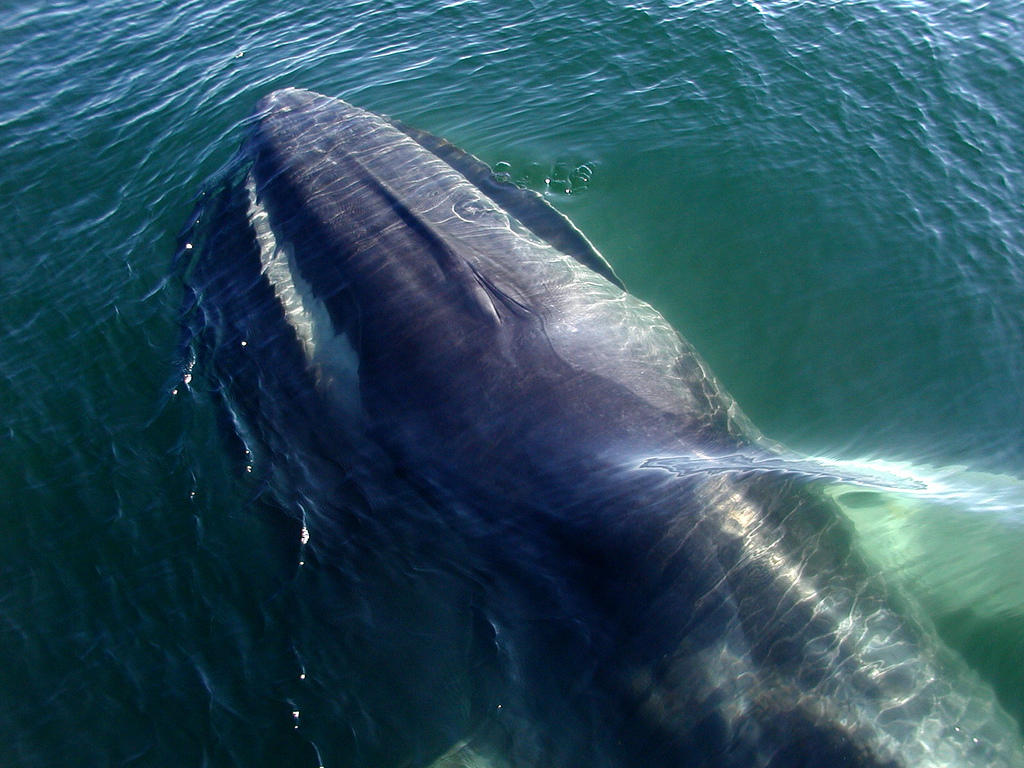9 December 2011
Singing whales take center stage in seismic study
Posted by kramsayer

Seismologists detected fin whale movements with ocean-bottom sensors off Vancouver, originally designed to study earthquake activity. (Credit: dryoptera / Flickr)
One man’s noise is another man’s data — which is why seismologists are giving marine biologists an unexpected boost these days.
Whale calls intrude on seafloor seismic recordings, prompting earthquake researchers to develop complicated algorithms for weeding out these cetacean bellows. Other scientists, however, have flipped these algorithms to search for the calls – and have created an extensive repertoire of whale songs.
“We just turned our code around,” said Dax Soule, a seismology graduate student at the University of Washington. He presented a poster on the effort Wednesday at the American Geophysical Union’s Fall Meeting.
Between 2003 and 2006, the researchers recorded about 300,000 fin whale calls near the Endeavour hydrothermal vents on the Juan de Fuca Ridge, off of Vancouver, British Columbia. The booming calls hit each of eight sea-bottom seismometers at slightly different times and strengths. Scientists traced the likely origin of each vocalization by the pattern of ringing that spread through the 10-kilometer-by-5-kilometer (6-mile-by-3-mile) sensor network. The researchers located whales to a precision of about 500 meters (0.3 miles).
Other seismologists have examined whale calls in the past, typically for only a few hours or days. So far, Soule’s team has analyzed a whole year of continuous recordings, allowing them to track whale movements for hours, days, and months at a time.
Some whales swam right through detection area at 7 to 8 kilometers per hour, while others meandered at a pace of 2 kilometers per hour. “We’ve got whales that dance around for about 20 to 30 hours,” Soule said.
Soule has also analyzed the timing of whale calls to tell whether the animals traveled alone or in groups. Calls spaced 25 to 30 seconds apart suggest single whales, while spreads of 13 seconds hint at two whales conversing. The seismometers also picked up dense clusters of vocalizations indicating whales traveling en mass.
From August to October, the researchers detected fin whales swimming mostly in groups, traveling northward through the area. The rest of the year, and especially during the winter breeding months, most whale calls came from single animals or pairs.
Whale paths did not span the detection area evenly, Soule said, but it’s not clear what pattern, if any, the animals followed. The movements did not, as researchers had initially suspected, line up along hydrothermal vents – where the fin whales might come to feed.
Adopting the team’s methods at other seafloor seismic networks in the region could provide more complete information about long-range swimming routes.
Marine mammal researchers have received the preliminary findings with enthusiasm, said Soule. Although the method only localizes actively calling animals, it complements existing techniques such as visual surveys and radio tagging.
The group’s work also attracts fans in the seismology community. “People love whales,” Soule said. “It’s not every day a geophysicist gets to give a talk on charismatic megafauna.”
– Helen Shen is a science communication graduate student at UC Santa Cruz



 GeoSpace is a blog on Earth and space science, managed by AGU’s Public Information staff. The blog features posts by AGU writers and guest contributors on all sorts of relevant science topics, but with a focus on new research and geo and space sciences-related stories that are currently in the news.
GeoSpace is a blog on Earth and space science, managed by AGU’s Public Information staff. The blog features posts by AGU writers and guest contributors on all sorts of relevant science topics, but with a focus on new research and geo and space sciences-related stories that are currently in the news.
[…] fin whale studies interesting, and interviewed Dax on Wednesday. Check out the article on Singing Whales! Tweet This entry was posted in gradschool, News, Science and tagged acoustics, […]
Information of these calls could be partly in ‘Rhythm Based Communication’ which: a) needs a cyclic temporal reference, and b) is encoded in ‘rhythmic durations.’ In other words consider the ‘Rhythm Based Time, T’ (referenced) between the calls rather than properties like energy which are commonly found in human ‘Signal Besed Communcation.’ This discovery is now described in a new book ‘Dancing With Nature’ (Amazon-Trafford) which follows ‘Dancing With Whales’ (Creative).
p.s. A possible rhythmic ‘temporal reference’ here for ‘Rhythm Based Communication, RBC’ could be sunrise
Your published photograph of a fin whale seems to have been reversed left to right as this species has a white lower right jaw and a darker lower left jaw!
whale !